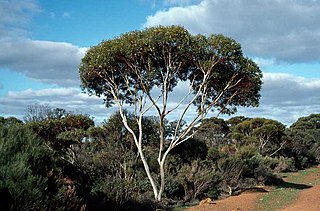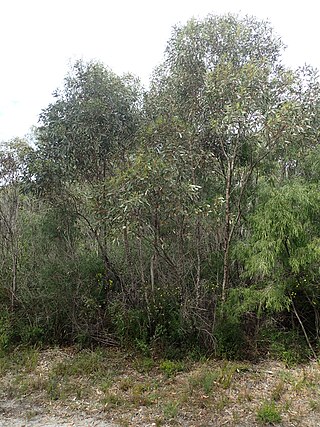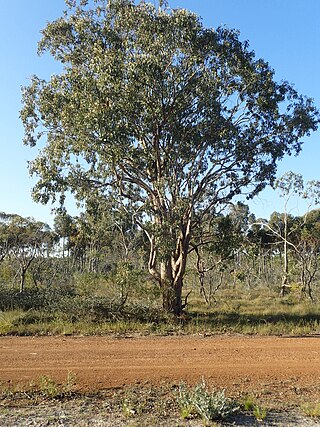
Eucalyptus erythronema, commonly known as the red-flowered mallee, is a species of mallee or tree and is endemic to Western Australia. It has smooth, dark pink to red bark that is shed to reveal whitish bark, and has lance-shaped adult leaves, pendulous flower buds mostly arranged in groups of three, red or yellow flowers and conical fruit.

Eucalyptus tetraptera, commonly known as square-fruited mallee or four-winged mallee, is a mallee that is endemic to the south coast of Western Australia. It has smooth bark, thick lance-shaped to oblong adult leaves, single flower buds arranged in leaf axils, red to pink flowers and square, prominently winged fruit.

Eucalyptus pyriformis, commonly known as pear-fruited mallee or Dowerin rose, is a species of low, straggly mallee that is endemic to Western Australia. It has smooth greyish brown bark sometimes with ribbony bark near the base, egg-shaped to lance-shaped adult leaves, flower buds in groups of three, red, pinkish or creamy white flowers and down-turned, conical fruit with prominent ribs.

Eucalyptus lansdowneana, commonly known as the crimson mallee or the red-flowered mallee box, is a species of slender stemmed, straggly mallee that is endemic to a restricted area of South Australia. It has rough, fibrous or flaky bark at the base, smooth, grey over creamy-white bark, lance-shaped adult leaves, flower buds in groups of seven, crimson flowers and barrel-shaped fruit.

Eucalyptus foecunda, commonly known as narrow-leaved red mallee, Fremantle mallee or coastal dune mallee, is a species of plant in the myrtle family that is endemic to Western Australia. It has rough bark on the trunk, smooth bark above, narrow lance-shaped adult leaves, flower buds in groups of nine or eleven, creamy white flowers and cup-shaped fruit. It was previously included with the more widespread Eucalyptus leptophylla.

Eucalyptus albida, commonly known as the white-leaved mallee, is a mallee that is endemic to the south-west of Western Australia. It has smooth white or greyish brown bark, lance shaped adult leaves, and flowers in groups of between seven and eleven. The flowers are creamy white and the fruit are hemispherical to cone-shaped. The juvenile leaves that are often retained on mature plants are arranged in opposite pairs, egg-shaped to heart-shaped and bluish grey.

Eucalyptus calycogona, commonly known as the gooseberry mallee or square fruited mallee, is a mallee that is endemic to southern Australia. It has smooth bark, narrow lance-shaped adult leaves, flower buds that are square in cross-section arranged in groups of seven in leaf axils, creamy white, sometimes pink flowers, and fruit that are square in cross-section.

Eucalyptus falcata, commonly known as silver mallet or toolyumuck, is a species of mallee or marlock that is endemic to Western Australia. It has smooth bark, lance-shaped to curved adult leaves, flower buds in groups of eleven or thirteen, creamy white or yellowish green flowers and flattened spherical fruit.

Eucalyptus goniantha, commonly known as Jerdacuttup mallee, is a species of mallee, or rarely a tree, that is endemic to Western Australia. It has smooth bark, lance-shaped adult leaves, flower buds in groups of between seven and eleven, creamy white flowers and more or less ribbed, hemispherical fruit.

Eucalyptus latens, commonly known as narrow-leaved red mallee, is a species of mallee that is endemic to the south-west of Western Australia. It has smooth grey and coppery bark, linear to narrow lance-shaped adult leaves, flower buds in groups of seven to eleven or more, creamy white flowers and small barrel-shaped to shortened spherical fruit.

Eucalyptus leucophylla, commonly known as Cloncurry box, is a species of tree or mallee that is predominantly found in northwest Queensland with small populations possibly also occurring in the eastern Kimberley region Western Australia. It has rough, finely fissured bark, lance-shaped adult leaves, flower buds in groups of seven, creamy white flowers and cup-shaped fruit.

Eucalyptus lucens, commonly known as the shiny-leaved mallee, is a species of mallee that is endemic to northwestern Australia. It has small, pale greyish to brown bark, glistening, lance-shaped adult leaves, flower buds in groups of seven on a branching peduncle, creamy white flowers and conical fruit.
Eucalyptus perangusta, commonly known as fine-leaved mallee, is a species of mallee that is endemic to a small area on the south coast of Western Australia. It has smooth bark, glossy green, linear leaves, flower buds in groups of seven or nine, creamy white flowers and short, barrel-shaped fruit.

Eucalyptus rigidula, commonly known as stiff-leaved mallee, is a species of mallee that is endemic to Western Australia. It has smooth bark, linear to narrow elliptic or narrow lance-shaped leaves, flower buds in groups of nine or eleven, creamy white flowers and barrel-shaped to hemispherical fruit.

Eucalyptus sheathiana, commonly known as ribbon-barked gum or ribbon-barked mallee, is a species of tree or a mallee that is endemic to Western Australia. It has smooth bark that is shed in long ribbons, lance-shaped adult leaves, flower buds in groups of seven, creamy white flowers and conical to cup-shaped fruit.
Eucalyptus xanthonema, commonly known as yellow-flowered mallee, is a species of mallee that is endemic to the south west of Western Australia. It has smooth bark, linear adult leaves, flower buds in groups of up to eleven, white to pale lemon-coloured flowers and barrel-shaped fruit.

Eucalyptus celastroides, commonly known by the Noongar name of mirret, is a species of eucalypt that is endemic to the south-west of Western Australia. It is a mallee, rarely a tree, and has rough bark on about half of the lower half of its tunk, smooth above, narrow lance-shaped adult leaves, flower buds in groups of seven or nine, white flowers and urn-shaped fruit.

Eucalyptus chlorophylla, commonly known as green-leaf box, northern glossy-leaved box or glossy-leaved box, is a species of eucalypt that is endemic to northern Australia. It is a tree or mallee, with hard, rough bark, lance-shaped or curved adult leaves, flower buds in groups of seven, creamy white flowers and usually conical fruit.

Eucalyptus cylindriflora, commonly known as the white mallee or goldfields white mallee, is a species of mallee that is endemic to the southwest of Western Australia. It has smooth bark, glossy green, linear adult leaves, flower buds in groups of seven, creamy white flowers and cylindrical to cup-shaped fruit.

Eucalyptus discreta is a species of shrub or mallee that is endemic to Western Australia. It has smooth creamy brown and pale grey bark, narrow-lance-shaped adult leaves, flower buds in groups of seven or nine, creamy-white flowers and barrel-shaped fruit.





















